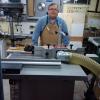So I've come across a few different designs for a better table saw for a crappy job site saw.
http://woodarchivist.com/3585-diy-table-saw-fence/
I like that this one isn't welded. It allows for some adjustment if it moves over time. The problem is I am not familiar with the peened over pins and I can't seem to find much help online about the process.
However. I also found this, which seems to be much more popular.
http://www.twistedknotwoodshop.com/P...quarefence.pdf
However, this one requires welding, which I am not familiar with, nor do I have the tools for it. All I have is soldering equipment. If I have start buying equipment, then it becomes too expensive and I'm putting too much money into a crappy table saw. I was looking at it, but I don't think I can make it where I can use screws and the screws won't interfere with the track.
Has anyone made any modifications to either one to make them easier to make? Thanks.




 Reply With Quote
Reply With Quote

